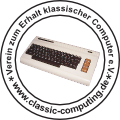Modular Synthesizer
OMG, I can't believe what I did... I spent half a fortune for a modular (mostly) analog synthesizer system! But anyway, no matter how cool software emulations like Cardinal might be, there's nothing like turning real knobs...
Here's my current configuration on modulargrids.net.
Random Chords 1
Von der Turing Machine zufällig im Quantizer ausgewählte Akkorde als super-schnelle Arpeggios.
Anmerkungen zum Patch
- Die Turing-Machine bespielt sehr langsam getaktet den Harmony-Eingang des Bard-Quartet-Quantizers.
- Steuerspannungen aus dem Doepfer-A-155-Sequencer werden in Bass-Lage auf den Grundton oder die Quinte des jeweiligen Akkords quantisiert.
- Bei jedem Sequenzer-Schritt wird ein Decay-Envelope ausgelöst, der sowohl den VCA als auch die Grenzfrequenz des VCFs des Bass-Oszillators moduliert.
- Über die Gate-Schalter des Sequenzers werden bei einigen Schritten schnellere Trigger zugeschaltet, um ein "Ratcheting" zu erreichen.
- Trigger-Schalter des Sequenzers lösen einen schnellen Decay-Envelope auf dem V/Oct-Eingang des Oszillators aus, was einem perkussiven Effekt zur Folge hat.
- In einem zweiten Kanal des Quantizers sind verschiedene Akkorde voringestellt, die einen schnellen Sägezahn-LFO quantisieren, was zu einen Arpeggio-Effekt führt.
- Per Sample&Hold wird dem Sägezahn noch ein zufälliger Offset beigemischt,. um den Akkord in verschiedenen Lagen erklingen zu lassen.
- Ein zweiter LFO moduliert den Low-Pass-Fileter des Oszillators, der die Arpeggios spielt.
Qi Gong I
A perfect ambient patch for practicing Qi Gong on the beach!
Patch Notes
- Finally, my Music Thing Modular Turing Machine has arrived! It provides the ever-evolving melody for the Berhringer 112 triangle oscillator.
- The ADDAC Bard Quarted is tuned to a pentatonic scale.
- The Turing Machine's pulse output triggers (after OR combination in the Klavis Two Bits with the Erica Synths Black Clock V2's DIV output at 2x speed) the Behringer 140 envelope generator.
- The bass line is produces by the Doepfer A-155 sequencer.
- The Behringer 150 multi-purpose module provides both the pink noise and the LFO used for creating the beach wave sound using the Behringer 121 filter.
Keep Talking!
A journey leading from purely electronic sounds to almost bird-like articulation!
Patch Notes
- Basic tones are provided by the Doepfer A-155 sequencer (with itts slew limiter turned to max).
- Some notes are triggered from the A-155, while others are triggerd by the Erica Synth Black Clock V2's random output, which runs with four times the base speed.
- The clock's speed is modulated by an LFO.
- The audible Behringer 112 triangle oscillator is frequency modulated by another, S&H tuned osciallator (first triangle, then sawtooth) in various octave ranages.
- For the bass sounds, first- and second-order sub-harmonics were created using the Doepfer A-160-2 clock divider and mixed int through the Berhinger 121 filter.
First Light
A telescope's initiation is termed "First Light". I'm really fond of this term, hence I used it for my first modular patch, too!
Patch Notes
- Some of the Doepfer A-155 sequencer steps are feed using the Behringer 150 multi purpose module's sample & hold capabilities.
- A-155 also triggers some note of the 8-step bass sequence.
- Klavis Two Bits acts as Bernoulligt gate and randomly lets some additional triggers pass through.
- Expert Sleepers Disting MK4 provides the delay effect.
- Towards the track's end, the Behringer 121 filter's cut-off frequency gets lowered while its resonance gets increased, leading to a heart-beat like sound.






![[Translate to English:] Modulares Synthesizer-System](/fileadmin/_processed_/4/3/csm_modular-synthesizer-system_beda4db22f.jpg)